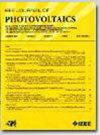Photovoltaic Cell Defect Detection by Lock-In Thermography Using 2-D Gaussian Profile
IF 2.5
3区 工程技术
Q3 ENERGY & FUELS
引用次数: 0
Abstract
The electrical energy produced by photovoltaic systems can be critically affected by a variety of factors. In order to detect defective photovoltaic cells, several monitoring techniques, such as lock-in thermography, have been widely used alongside some analytical methods that avoid subjectivity. This article proposes a method with low computational cost that provides a simple and easily implementable way to quantifiably discern if a photovoltaic cell is defective or not. A two-dimensional Gaussian fit is applied to images generated by fast Fourier transform and principal component analysis algorithms on thermographic data from lock-in thermography tests. The considered coefficient of determination利用二维高斯轮廓锁定热成像技术检测光伏电池缺陷
光伏系统产生的电能会受到各种因素的严重影响。为了检测有缺陷的光伏电池,一些监测技术,如锁定热成像技术,以及一些避免主观性的分析方法已被广泛使用。本文提出了一种计算成本较低的方法,它提供了一种简单且易于实施的方法,可定量判别光伏电池是否存在缺陷。通过快速傅立叶变换和主成分分析算法,对锁定热成像测试的热成像数据生成的图像进行二维高斯拟合。结果发现,所考虑的判定系数 ${R}^2$ 是拟合质量的良好衡量标准。此外,该方法在第一主成分({R}^2$介于 0.944 和 0.986 之间)和幅值图像({R}^2$介于 0.965 和 0.985 之间)上的应用潜力也很突出,可用于识别和区分非缺陷细胞和缺陷细胞。
本文章由计算机程序翻译,如有差异,请以英文原文为准。
求助全文
约1分钟内获得全文
求助全文
来源期刊

IEEE Journal of Photovoltaics
ENERGY & FUELS-MATERIALS SCIENCE, MULTIDISCIPLINARY
CiteScore
7.00
自引率
10.00%
发文量
206
期刊介绍:
The IEEE Journal of Photovoltaics is a peer-reviewed, archival publication reporting original and significant research results that advance the field of photovoltaics (PV). The PV field is diverse in its science base ranging from semiconductor and PV device physics to optics and the materials sciences. The journal publishes articles that connect this science base to PV science and technology. The intent is to publish original research results that are of primary interest to the photovoltaic specialist. The scope of the IEEE J. Photovoltaics incorporates: fundamentals and new concepts of PV conversion, including those based on nanostructured materials, low-dimensional physics, multiple charge generation, up/down converters, thermophotovoltaics, hot-carrier effects, plasmonics, metamorphic materials, luminescent concentrators, and rectennas; Si-based PV, including new cell designs, crystalline and non-crystalline Si, passivation, characterization and Si crystal growth; polycrystalline, amorphous and crystalline thin-film solar cell materials, including PV structures and solar cells based on II-VI, chalcopyrite, Si and other thin film absorbers; III-V PV materials, heterostructures, multijunction devices and concentrator PV; optics for light trapping, reflection control and concentration; organic PV including polymer, hybrid and dye sensitized solar cells; space PV including cell materials and PV devices, defects and reliability, environmental effects and protective materials; PV modeling and characterization methods; and other aspects of PV, including modules, power conditioning, inverters, balance-of-systems components, monitoring, analyses and simulations, and supporting PV module standards and measurements. Tutorial and review papers on these subjects are also published and occasionally special issues are published to treat particular areas in more depth and breadth.
 求助内容:
求助内容: 应助结果提醒方式:
应助结果提醒方式:


